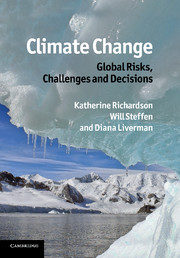Book contents
- Frontmatter
- Contents
- Writing team
- Foreword
- Preface
- List of acronyms and abbreviations
- Part I Climatic trends
- Part II Defining ‘dangerous climate change’
- 5 The impact of climate change on human societies
- 6 Impacts of climate change on the biotic fabric of the planet
- 7 Tipping elements: jokers in the pack
- 8 Linking science and action: targets, timetables and emission budgets
- Part III Equity issues
- Part IV Mitigation and adaptation approaches
- Part V Meeting the challenge
- Index
- Plate section
- References
5 - The impact of climate change on human societies
Published online by Cambridge University Press: 04 April 2011
- Frontmatter
- Contents
- Writing team
- Foreword
- Preface
- List of acronyms and abbreviations
- Part I Climatic trends
- Part II Defining ‘dangerous climate change’
- 5 The impact of climate change on human societies
- 6 Impacts of climate change on the biotic fabric of the planet
- 7 Tipping elements: jokers in the pack
- 8 Linking science and action: targets, timetables and emission budgets
- Part III Equity issues
- Part IV Mitigation and adaptation approaches
- Part V Meeting the challenge
- Index
- Plate section
- References
Summary
‘At many church services in Denmark during the world climate conference three special things will be brought into church and placed on the altar: a stone, a corn cob, and a fragment from a coral reef. The stone is from Greenland, the corn cob is from Malawi, and the coral from the Pacific Ocean … All three things remind us that climate change caused by human activity affects living conditions around the world …’
Scientists have now documented numerous anthropogenic influences on several components of the climate system and identified an overwhelming probability that the changing climatic conditions recorded on Earth over the past decades are primarily a response to this human interference of the climate system (Zhang et al., 2007). All of this would, however, be of purely academic interest but for the fact that these changes in climate conditions influence the conditions for all life on Earth. Of particular and immediate interest to all concerned citizens of the world is, of course, how does or will climate change affect me, my family and my community?
Understanding the potential impacts of climate change on our societies is directly relevant to the question of what constitutes ‘dangerous climate change’. As the magnitude and rate of climate change increases through this century, the consequences for us and our societies also escalate. At some point, the impacts of climate change will become too large and costly – economically, socially, environmentally – for societies to adapt.
- Type
- Chapter
- Information
- Climate Change: Global Risks, Challenges and Decisions , pp. 101 - 133Publisher: Cambridge University PressPrint publication year: 2011



